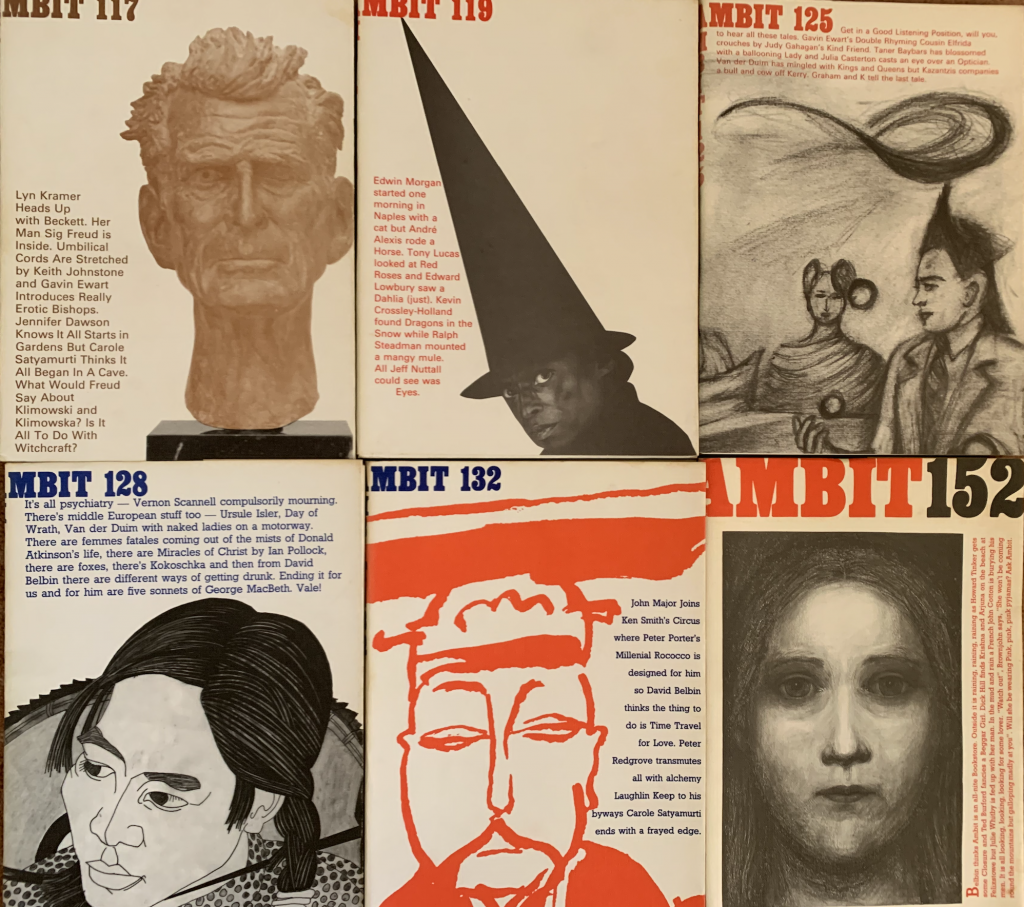A Farewell to Ambit

I was sad to spot on Instagram yesterday that Ambit magazine is closing down. Its final issue, number 249, is launched tonight. 250 would have made for a round number, but Ambit was never the sort of journal to be interested in neatness. I can’t make it to London, so offer this brief tribute instead.
Ambit is nearly as old as me, first published in 1959 with a heyday that coincided with the swinging sixties and went on long beyond it. Founded by Dr Martin Bax, it was closely associated with the artist Ralph Steadman, who drew for it frequently, Bax’s close friend, the great SF writer J.G. Ballard, poet Adrian Mitchell and artist Michael Foreman. It always combined cutting edge literature with art and had an influence beyond its modest circulation, not least because it was so beautifully produced, subsidised, I suspect, largely from Martin’s income as a paediatrician rather than Arts Council grants.
In later years, Carol Ann Duffy came on as Poetry editor and Geoff Nicholson took over from JG as Fiction editor. I also want to mention their most frequent poetry reviewer and one of my favourite living poets, Jim Burns, whose work I first came to know via Ambit and the late Julia Casterton, a fine poet and creative writing tutor who was an assistant editor at Ambit and, towards the end of her life, the external examiner on the Creative Writing MA at Nottingham Trent, which I ran for many years.
Through Julia, I was told how my first short story came to be accepted by Ambit back in 1989. I’d been writing seriously for five years by then, but had had nothing published, just a lot of ‘nearly but not quite’s for my novels and stories. I sent ‘Witchcraft’ to Ambit largely because I knew the magazine took six months to reply (once you were in, the response time became rather quicker) and was fed up of sending the piece out. I held out little hope because it was so controversial. The very short story was inspired by Nottingham’s ‘Satanic’ child abuse cases, which were about to make headlines and which I’d heard about via a social worker friend long before they were common knowledge. It’s written from the point of view of a very young, abused girl. It was the best thing I’d written up to that point but the story was as unflinching as one of Kevin Coyne’s songs about abuse and despair.
There was considerable debate about whether to publish the story, Julia told me, fifteen years later. It turned out she’d even written an article about it for Poetry London. The deciding factor was Ballard’s argument that the story was brave and ‘for the child’. In it went, with two beautiful illustrations by Michael Foreman. A dozen or so years later, when I tried to republish the story in an anthology of YA stories, the editor was told that if my story appeared, libraries wouldn’t stock the book, so it had to be replaced, which reinforces how brave Ambit had been in publishing it. ‘Witchcraft’ can now be found in my new and collected Provenance, along with other stories that first appeared in Ambit. So far, there’ve been no complaints.
Within a few months, the magazine took a new story about an abused child Being Bullied, based on the account of a Pakistani boy I taught who’d been strong armed into becoming a drugs courier. Martin then took two of the ‘Alison’ stories that led into my Five Leaves novel Student. My Ambit run finished with a sort-of-sci-fi story that JG got me to cut by a quarter called Love, Time Travel, the only one of my stories that’s ever been optioned for a movie. No, it didn’t get made and I didn’t make money, but the option shows that Ambit had a wide reach and punched above its weight. Later, another story that used the same concept I’d come up with did become a movie and TV series, neither of which I’ve seen, called, The Time Traveller’s Wife. I know the author a little, but have never mentioned this similarity to her, as ideas are in the ether and I’m certain she had no idea about my earlier version. If I’d had any sense, I’d’ve expanded the idea into a novel myself. I was in a good position back then because one of those Ambit ‘Alison’ stories, ‘Different Ways of Getting Drunk’ was taken for Best Short Stories of the Year: 1993 edited by Giles Gordon and David Hughes, where I was in the same volume as Martin Amis, Nadine Gordimer and Alice Munro. This got me my one review in the Mail – they referred to me and John Banville as ‘younger talents’. I bought Ken Cox’s illustration from him and it hangs in my university office, where not a single student has ever commented on the figure giving cunnilingus, the magic mushrooms or Ken’s uncanny depiction of a child in a toy car that so closely resembles a photo of me taken by my dad in the early 60s.
That I didn’t publish much in Ambit after that wasn’t due to rejection but was down to the success of my more commercial career, writing YA novels. In 1994, I achieved my ambition of becoming a full time writer, but I was only able to do this by writing four or five novels a year plus short stories that paid a hundred pounds per thousand words (as against the twenty or thirty quid I got from Ambit which, unusually for a small journal, did at least pay). I ran out of the time and headspace required to write adult short stories. Around the time that Geoff took over from JG they did use one tiny short story of mine ‘In the All Night Bookstore’ inspired by our first trip to the United States back in 1992. The anglicised, slightly improved version of this story can be found in the Candlestick Press ‘instead of a card’ chapbook ‘The All Night Bookshop’.
I’m not sure which story was the occasion of my one trip to an Ambit launch (the early trains back to Nottingham made such things tricky unless, as on this occasion, I stayed with a friend in London) at Bernard Stone’s famous Turret bookshop. I remember Gavin Ewart reading, Jim Burns sloping off early, a woman outside haranguing Geoff N and I because we ought to be writing about female genital mutilation and a very pleasant dinner at a nearby restaurant that Martin’s son, Tim, insisted on paying for. I got on well with Geoff and began to read his novels. We’ve since become better acquainted and I was meant to be doing a bookshop event with him just as Covid hit. This was replaced by an online event for Nottingham UNESCO City of Literature which you can still read and hear by following the link.
Ambit didn’t take everything I sent. I remember trying them with a story from the mid-noughties (‘Remains’, which can be found in Provenance) and Martin telling me it was ‘too literary’, which was fair enough. Ambit was never a literary journal, it was an eclectic, eccentric, ambitious, rather beautiful, decidedly idiosyncratic quarterly with an unashamed enthusiasm for sex, the avant-garde and values that were first espoused in the late sixties. But it wasn’t stuck in the past. You’d find big names in there (including artists like Paolozzi) but the magazine always supported and sought out the new, as a good journal should. The reviews sections were always interesting, too, and I wrote a few poetry reviews for it, but my life was changing when, in 2002, I got the job at NTU that I still do, two days a week. NTU took Ambit in the university library and I was running out of shelf space at home (still am), so, shamefully, I let my sub lapse later in the noughties. That said, I always kept up with the magazine, which maintained its quality even as Martin’s health faded and his cousin-in-law Briony (daughter of poet Adrian Mitchell) took over. In 2020 Kirsty Allison took the reins, with Briony remaining as editor emeritus.
Julia Casterton died young, in 2007. I wrote about her here. Jim Ballard died two years later. Geoff Nicholson is still writing great books and Jim Burns is still writing great reviews and poems. After tonight, though, Ambit will be no more. But all those great issues live on, because it’s not the sort of magazine anyone throws away. I’ve got over a hundred in an archival box in our library garage. You can buy many of their wonderful back issues, including the ones pictured above, for £5 in their fire sale. That link also takes you to details of tonight’s launch party in Peckham. I’ll be there in spirit. Sending warm thoughts to Ambit and everyone who sailed in her, especially Captain Martin, who began the voyage and steered the ship for so long. My life and that of many others would have been rather different, and lesser, without you. Thanks.

David, a very nice tribute and account of your own writing journey. Ambit meant a lot to me as well, publishing my first short story in 144, and a handful after that. Good luck with your work. I join you in saluting Martin and all the crew who worked with him.
Thanks for that, Joel, and all the best to you too. It seems there was the possibility of another publisher taking over until Friday afternoon, but it fell through, hence the announcement then. Sad, but what a legacy!
“The deciding factor as Ballard argument that the story was brave and ‘for the child’.” Should that read “[w]as Ballard[‘s] argument,” or did you intend some other form of words? In any case, thanks for the anecdote!
Hi David, just having a minute to read this.
Briony Bax was not Martin’s daughter-in-law but his cousin-in-law. She was appointed by Tim Bax, Martin’s son, who later became chairman when she made Ambit into a charity.
Also, Martin worked as a paediatrician rather than GP.
Kirsty Allison, Ambit Editor, 2020 – 2023
Thanks for that, David.Of course you’re right and I’ll correct the typo! And I’ve made the corrections you pointed out, Kirsty. Thanks and good luck.